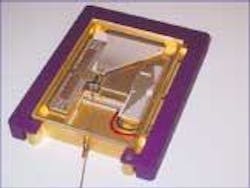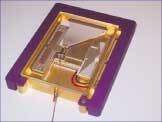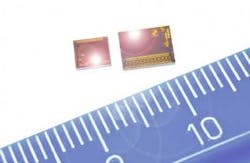OEO is good, says startup Infinera
While the vision of an all-photonic network is not as vivid today as it was two or three years ago, many systems vendors continue to tout optical add/drop multiplexers, all-optical switches, and Raman-supported ultra-long-haul optical systems as the best way to remove cost from the network, because they reduce the number of expensive optical-electrical-optical (OEO) conversions. However, a startup company suggests that advances in silicon technology can reduce the cost of OEO conversion so significantly that tomorrow's networks will have more OEO conversion points, not fewer.
Infinera (Sunnyvale, CA) states its case this month as it introduces the DTN Digital Optical Network System, which offers add/drop, switching, and transport capability at a 10-Gbit/sec line rate. It supports a wide variety of interfaces and 10 &#times; 10 Gbits/sec per card, 400 Gbits/sec in a half-rack, and 800 Gbits/sec in a full rack. And Infinera is proud to tout its embrace of OEO conversion.The problem with minimizing the number of OEO nodes in the network, according to Infinera chief executive and co-founder Jagdeep Singh and product marketing director Rick Dodd, is that a carrier's ability to access the bits that make up the signal is also reduced. Thus, while the services that carriers offer have become increasingly digital, the infrastructure on which those services ride becomes more analog as photonic nodes replace OEO points. The all-optical network also decreases flexibility because carriers have to make a best-guess estimate of where they'll want add/drop capability in the future. Carriers risk either stranding assets if they overestimate traffic demand or paying the price of backhaul links or adding equipment if they underestimate.
The smart thing, say the Infinera spokesmen, is not to replace OEO conversion, but decrease its cost. The company believes it has done that through the development of two "photonic integrated circuits" (one for transmission, the other for reception) that between them use indium phosphide advances to provide the major functions of a 10-wavelength DWDM transponder, including lasers, modulators, and a multiplexer in the transmitter chip and a photodiode and demultiplexer in the receiver chip.
The decrease in packaging complexity and increase in efficiency results in a 10:1 savings over the use of discrete devices, Singh and Dodd claim. The resultant low initial capital investment for DTN makes it economical not only to install the system where a carrier currently has add/drop nodes or envisions their necessity, but at all amplifier and regeneration sites as well. The comparatively shorter distances between DTNs versus other optical transport systems enable the use of simpler low-cost amplifiers and obviate the need for high-end signal management technology such as dispersion compensators and gain equalizers. Such links should also prove less complex to engineer, reducing operating expenditures (opex).
The increase in OEO points further shrinks opex by easing fault isolation and taking the guesswork out of network planning, Singh and Dodd note. Thus, they believe that carriers will want to leverage Infinera's systems to add OEO conversion points to their networks, not remove them. Singh says carriers have told him that the technology will enable service providers to return to the way they planned network architectures before the advent of DWDM. Such networks more closely mirror the digital nature of the services they carry, according to the Infinera staffers.
Analysts who have seen the DTN system believe Infinera has a compelling story. "I think over the last two or three years, it's probably the most impressive startup I've met," offers Scott Clavenna, president of market research and analysis firm PointEast Research LLC (San Francisco). "Assuming it all works and there's no fatal flaw in the chips, as far as I can see it's the most profound change in optical networking since the EDFA."
Maria Zeppetella, vice president of optical infrastructure markets at Probe Group LLC (Cedar Knolls, NJ), also gives the company high marks. "They sound like a really interesting company," she explains. "I think they have a good product, and I think they're looking at the market right. In these times, when there are so many startups that are just falling off the edge of the planet, I don't think this is going to be one of them. I think that they're going to go places."One shortcoming the Infinera approach shares with the all-optical equipment at the other end of the technology spectrum is the need to convince carriers to replace their legacy systems with new boxes. Singh and Dodd say the low cost of DTN compares favorably to the cost of adding "a few" wavelengths to existing systems—and particularly to the cost of adding add/drop capability to a site where it currently doesn't exist. Thus, they foresee carriers adopting a "cap and grow" strategy where they place DTNs next to legacy systems, and exclusively use DTNs to add capacity and services as their networks evolve.
While conceding that this vision is not untenable, Clavenna believes Infinera's entry into carrier networks will occur more selectively and slowly. "I would think what would be a likely entry strategy is using the Infinera box as an add/drop node first, to be able to peel off traffic very easily from these points in the network where right now there's just an amplifier, and then see if that works, get used to the system, and then build the network from those points out," he says. He sees tier two and tier three carriers supporting regional networks with many add/drop sites as Infinera's most likely first customers.
All of the sources contacted for this story concede that OEO versus all-optical technology can take on religious overtones with certain carriers—and the analysts say some carriers are currently bent on going all-optical. Still, many carriers would be willing to embrace the Infinera approach, Clavenna and Zeppetella say.
"If this works, I think it's just absolutely profound, and the Cienas and Siemens and Alcatels and Lucents have to go back and look at what they have to offer and go, 'My God, there's no way we can match them on price and performance and functionality.' It's like all three aspects of optical transport systems are addressed head on with this," Clavenna says.
Infinera should have systems ready for trials in the third quarter of this year. "Right now, their timing lines up just right with what we see in our forecasts," says Zeppetella. "We see buying decisions being made for carriers that have just taken their legacy equipment as far as they can go and they've got to upgrade. And that's going to happen in 2005 and 2006."


